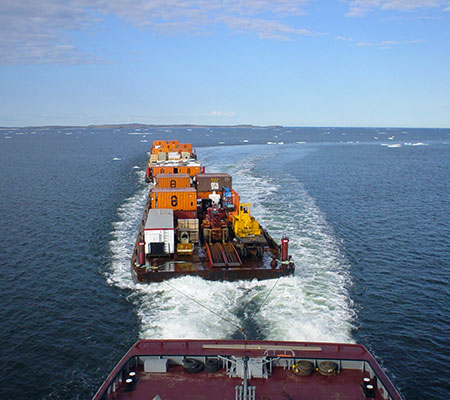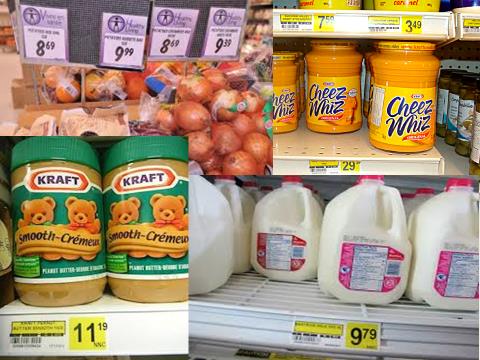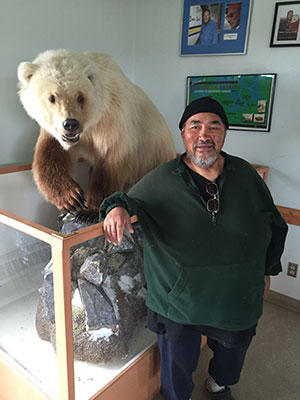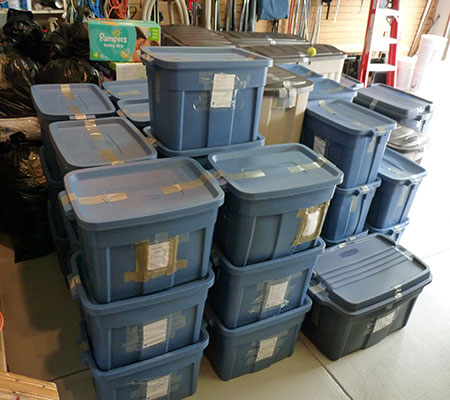A remote hamlet of 400 people benefits from a sea can of donated supplies
 Shopping for basic necessities in the Canadian North can be prohibitively expensive.
Shopping for basic necessities in the Canadian North can be prohibitively expensive.
Visit a grocery store in a community accessible only by sea or air and you may find $10 gallons of milk, $12 jars of peanut butter and – if you can afford a treat – $30 jars of Cheez Whiz or $5 cans of pop.
Ulukhaktok, a hamlet of 400 people on Victoria Island (pictured above), just north of mainland Northwest Territories, is one of those communities.
It’s also a 2-time beneficiary of the North of 60 project, an initiative of The Society of St. Vincent de Paul (SSVP). The project fills storage containers with much-needed supplies, offsetting the extreme costs of essential products for 10 northern communities.
Last summer, NAIT staff member Linda Tutt, as chair of SSVP’s St. Albert conference, coordinated the filling and transport of a sea can shipping container, sending approximately $25,000 worth of donations to Ulukhaktok. The hamlet is 2,000 kilometres away by air. Tutt made the trip last fall to get a sense of how SSVP can serve the community as best it can.
 A small window for sea travel
A small window for sea travel
For deliveries, “Travel is by truck to Hay River [NWT] then by floated sea barge down the Mackenzie River and across the Northwest Passage [above] to the community,” says Tutt, who works at NAIT as an administrative assistant.
This trip can be made only in the summer, when the Passage isn't frozen over. The community relies on water transportation for most of its deliveries, receiving one barge annually with a year’s worth of the supplies, vehicles, housing materials and more, including the SSVP donations.
The sea can complements that delivery and includes specific supplies requested by the community, which is heavily reliant on hunting and fishing. “We involve them and gather their needs,” says Tutt.
“When I was there the sea barge was delayed, so there were many empty spots on the grocery shelves.”
 Now known as “the sea can lady” to those in the community, Tutt has helped include items such as hockey sticks, beds, hand-knit blankets, toques and baby items and clothes (gathered below). David Kuptana (left), an elder in the community, distributes the container’s contents throughout the year to those in need.
Now known as “the sea can lady” to those in the community, Tutt has helped include items such as hockey sticks, beds, hand-knit blankets, toques and baby items and clothes (gathered below). David Kuptana (left), an elder in the community, distributes the container’s contents throughout the year to those in need.
Kuptana was born in the community and has lived there all his life. He hopes Ulukhaktok and SSVP will “keep working together and help each other.”
Filling a need
During her week in the community, Tutt had the chance to see the impact of the efforts firsthand.
Thanks to donated tickets, she made the approximately $2,100 flight (each way) to meet community members and see how her group could ensure that needs will continue to be met in the face of challenges imposed by weather and the remoteness of the location.
The seacan has been well received. In particular, Helen Kitekudlak notes the infant items donated by the Baby Box Company and dried Okanagan Valley produce from Gleaners.

“Items given to our Canada Prenatal Nutrition Program women have been really been something they look forward to – especially those who can’t afford much,” says Kitekudlak, a retired educator who runs the program.
“The dried vegetables are great. The women in the cooking group each take a bag home and report back to the group how they created different recipes adding meat and flavourings. We were all in awe when we opened the boxes full of beautiful items.”
Tutt will continue as chair of the North of 60 project for Ulukhaktok and looks forward to the next sea can preparation and delivery.
“We’ll start collecting again in the spring,” she says.